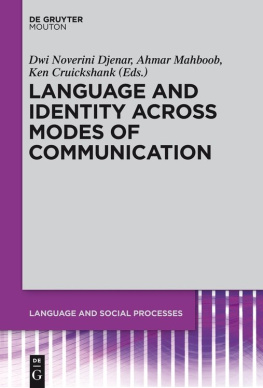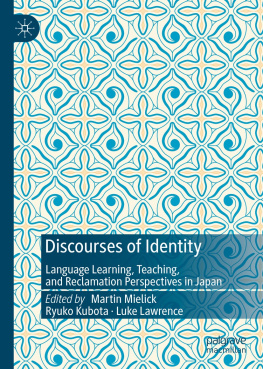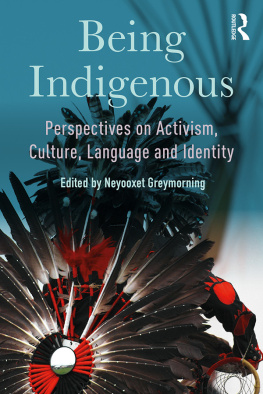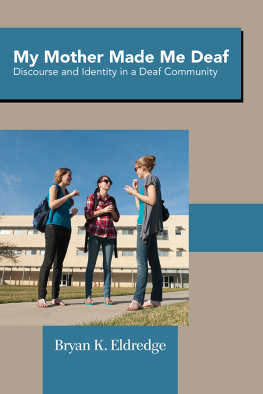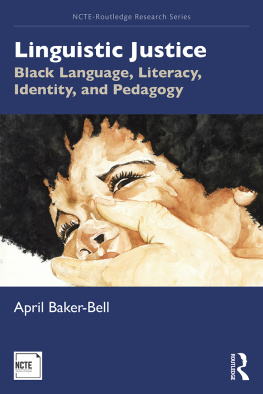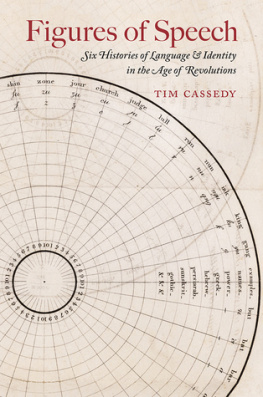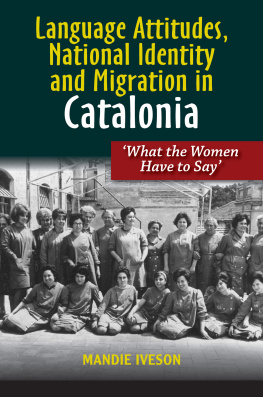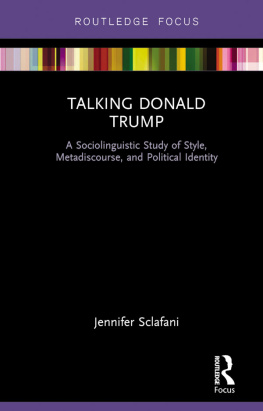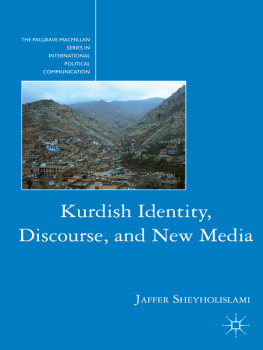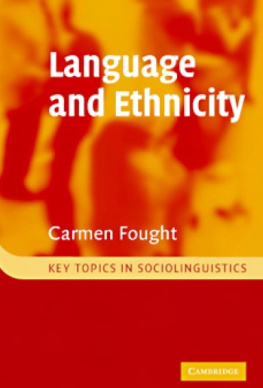Ahmar Mahboob - Language and Identity across Modes of Communication
Here you can read online Ahmar Mahboob - Language and Identity across Modes of Communication full text of the book (entire story) in english for free. Download pdf and epub, get meaning, cover and reviews about this ebook. year: 2015, publisher: De Gruyter Mouton, genre: Politics. Description of the work, (preface) as well as reviews are available. Best literature library LitArk.com created for fans of good reading and offers a wide selection of genres:
Romance novel
Science fiction
Adventure
Detective
Science
History
Home and family
Prose
Art
Politics
Computer
Non-fiction
Religion
Business
Children
Humor
Choose a favorite category and find really read worthwhile books. Enjoy immersion in the world of imagination, feel the emotions of the characters or learn something new for yourself, make an fascinating discovery.
- Book:Language and Identity across Modes of Communication
- Author:
- Publisher:De Gruyter Mouton
- Genre:
- Year:2015
- Rating:4 / 5
- Favourites:Add to favourites
- Your mark:
- 80
- 1
- 2
- 3
- 4
- 5
Language and Identity across Modes of Communication: summary, description and annotation
We offer to read an annotation, description, summary or preface (depends on what the author of the book "Language and Identity across Modes of Communication" wrote himself). If you haven't found the necessary information about the book — write in the comments, we will try to find it.
Language and Identity across Modes of Communication — read online for free the complete book (whole text) full work
Below is the text of the book, divided by pages. System saving the place of the last page read, allows you to conveniently read the book "Language and Identity across Modes of Communication" online for free, without having to search again every time where you left off. Put a bookmark, and you can go to the page where you finished reading at any time.
Font size:
Interval:
Bookmark:
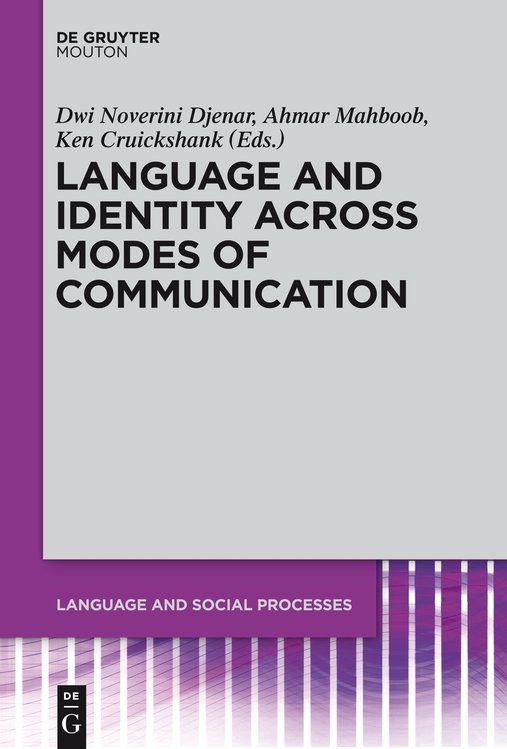
In 2011 a group of researchers with shared interests in aspects of linguistics and identity, and working in a range of research approaches across the Faculties of Arts and Social Sciences, and Education and Social Work at the University of Sydney, came together to form the Language and Identity Research Network. The group organized workshops and symposia in 2011 and 2012 supported by funding from the Faculty of Arts and Social Sciences Collaborative Research Scheme.
The present book developed from the first symposium held at the University of Sydney, 2122 November 2011. We thank the national and international contributors to this symposium and those who went on to contribute chapters to this book. We also acknowledge the work of Lydia Dutcher for her diligence in final editing.
Dwi Noverini Djenar, Ahmar Mahboob, Ken Cruickshank
ideology (Kroskrity 1993, 2000), translation (Cronin 2006), language learning and learner identity (Norton 2000; Block 2007), digital media (Thurlow and Mroczek 2011), national, ethnic, and religious affiliations (Joseph 2004), and race (Bucholtz 2011; Reyes 2011), to mention just a few. The proliferation of identity studies has led some cynics to comment flippantly that mentioning the word identity in research proposals is a popular strategy for assuring research funding. Others are concerned that the popularity makes the currency of the topic become considerably cheapened (Edwards 2009: 2). Criticisms aside, scholars have acknowledged that interest in the topic is yet to show signs of abating. The recounted exchange below between a PhD candidate at an Indonesian university and her supervisor is a good illustration of how identity as a research topic continues to attract new adherents.
In a recent visit to Australia, the said PhD candidate recounted how, shortly after the commencement of her candidature, she sought her supervisors approval for her chosen thesis topic, teacher identity in the EFL classroom. Upon hearing the word identity the supervisor asked in earnest: Identity? What is it anyway? And why do you want to write about it? The candidate now a graduate explained by reminding the supervisor that their government had been talking about education as an element of nation building, and that a study on teacher identity would help people make sense of that discourse. The supervisor was, of course, familiar with the discourse, but he was interested to know how the notion of nation building could be analysed in terms of identity. Apparently the supervisor was perplexed at the mention of identity. It was only after a lengthy explanation was given that he allowed the student to proceed with the topic. This story reminds us not only that identity is a popular topic but also that it has developed into a new frame for understanding perennial concerns. In this case, a concept which had hitherto been couched in a metaphor involving physical construction (nation building) is now framed as a concern about self/group-definition (national identity). Thus the previous conceptualization of nation as something that needs to be built is now reframed as a concern about defining what it means to be teachers that is, to be members of a professional group within the collective entity that is nation. The studies in this book endeavour to interpret different social phenomena also within the frame of identity. Indeed, many of the studies demonstrate that it is issues to do not only with prescribed national ethos, but also with local/community ethos, that have important implications for peoples sense of belonging.
Various scholars have offered explanations as to why identity has become a major concern in societies across the globe. According to Bauman (2004: 13), the breakdown of welfare states and spread of contestation, as some of the contributions in this book demonstrate. Identity, as Bauman (2004: 13) asserts, is not only the case of one freely ascribing ones own self-characteristics but also of others imposing them on us, such that acts of vigilance and self-defence are often called for: Identities float in the air, some of ones own choice but others inflated and launched by those around, and one needs to be constantly on the alert to defend the first against the second; there is a heightened likelihood of misunderstanding and the outcome of the negotiation forever hangs in the balance. The issue of national identity provides a good example of how having a sense of belonging involves more than just citizenship. Part of the conceptualization of national identity is having a national language, and thus to belong to a nation requires that one identifies with the language of the state (Anderson 1991). In multilingual societies, the decisions about which language should be chosen as the language of the state, or what level of competence in the national language new migrants should achieve, have long been shown to be thorny issues. Also, what constitutes an acceptable variety of the language does not always coincide with the variety one prefers to use (Stroud and Wee 2012: 15). In this scenario, identity may turn out to be something imposed by others rather than an affiliation of choice.
While Bauman stresses identity as a potential discord that arises between ones chosen position and others perception of that choice, and between ones choice and others imposition, Burke and Stets (2009) emphasize the non-unitary nature of identity. To them, identity is the set of meanings that define who one is as one assumes different roles in society. It is meanings that individuals apply to or claim for themselves as they occupy these roles. For example, one might occupy the role of a student, worker, parent, spouse, or member of an ethnic group or political party, or any combination of these roles. Thus identity is necessarily multiple; as people occupy multiple roles they claim characteristics for those roles. Burke and Stets also stress that identities are grounded in society (or social structures in their term). This social dimension is understood in two senses. First, identities are roles assumed by an individual and between individuals, hence they are shared in society; second, individuals exist in a society, and therefore they exist within the context of social structure (Burke and Stets 2009: 3). In this regard, society is the necessary backdrop in which individual and group identifications are situated. Both Bauman and Burke and Stets highlight identity as an ongoing social process, an as-yet-unfulfilled, unfinished task in Baumans (2004: 20) words. In this respect, individuals and groups are both the agents and objects of such processes (Burke and Stets 2009: 9). As Bucholtz and Hall (2004: 492) point out, as agents, individuals or groups are subject of those processes, while as object, they are subject to them.
However, identity is also a term used to foreground a state of being at a particular time. To say that someone is a teacher and member of a political party, for example, is to identify the person synchronically with reference to a social category, including the kind of job they do and the group they affiliate with. This identification takes for granted the process involved in negotiating and maintaining these roles. Similarly, to say that one is an Australian or a New Zealander is to imply that one is from a particular place or has a formal affiliation with a particular state. In other words, the stative use of the term assigns to the background details to do with the processes of identity formation. Nevertheless, these backgrounded elements are always present. These are what sociolinguists refer to as the brought along elements (Li Wei 1998). Thus, even in the stative sense, identity is both a snapshot of an individual or a group of people and a process of becoming. They are two sides of the same coin. Our purpose in this chapter is to highlight the contributions in this book with reference to these dual dimensions of identity. In doing this we underscore the role of language as a significant mode of communication. In the following section we discuss further what we understand by mode of communication.
Font size:
Interval:
Bookmark:
Similar books «Language and Identity across Modes of Communication»
Look at similar books to Language and Identity across Modes of Communication. We have selected literature similar in name and meaning in the hope of providing readers with more options to find new, interesting, not yet read works.
Discussion, reviews of the book Language and Identity across Modes of Communication and just readers' own opinions. Leave your comments, write what you think about the work, its meaning or the main characters. Specify what exactly you liked and what you didn't like, and why you think so.

